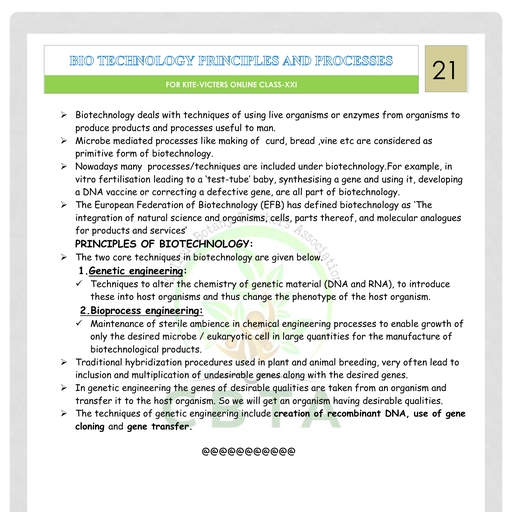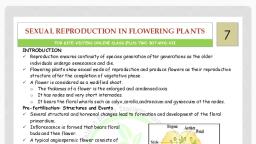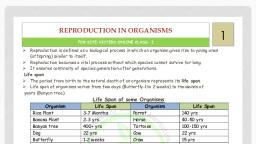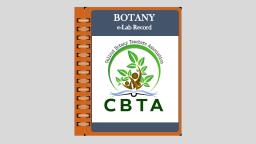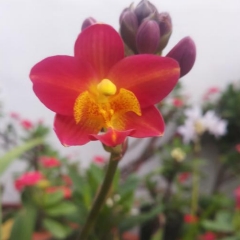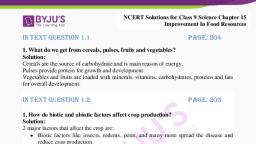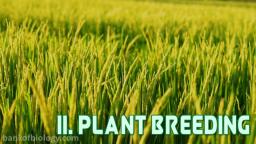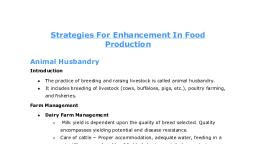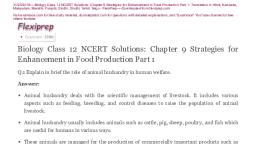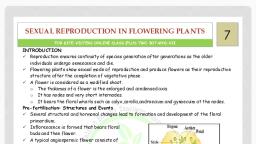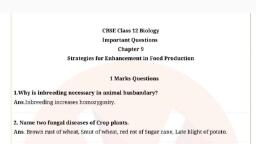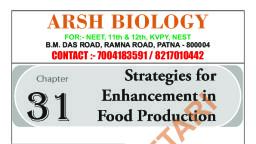Page 1 :
STRATEGIES FOR ENHANCEMENT IN FOOD, PRODUCTION, , 15, , FOR KITE-VICTERS ONLINE CLASS-XV, , The growing world population is accompanied by many problems, the most important is being shortage, of food materials., Scientists all over the world are engaged in finding out new methods for enhancement in food, production, To fulfil the demand of food items due to increasing population, biological principles are applied in, animal husbandry and plant breeding., Animal Husbandry, o It is a branch of agriculture concerned with rearing, breeding and feeding animals to obtain useful, products., o Animal husbandry deals with the care and breeding of livestock like buffaloes, cows, pigs, horses,, cattle, sheep, camel goat etc., o It also includes poultry farming and fisheries., o Fisheries include rearing, catching, selling, etc., of fish, molluscs (shell-fish) and crustaceans, (prawns, crabs, etc.), o More than 70% of the livestock population in the world live in India and China., o However, the contribution to the world farm produce from these countries is only 25%, i.e., the, productivity per unit is very low., Management of Farm and Farm Animals, A professional approach of farm management have increased the food production many folds. Some of, the management procedures applied in various livestock are as follows, Dairy farm management, o Dairying is the management of animals for its milk and its product for human consumption., o In dairy farm management, we deal with processes and systems that increase yield and improve, quality of milk., o Selection of good breeds having high yielding potential, combined with resistance to diseases is, very important., o Cattle have to be housed well, should have proper water and be maintained disease free., o The feeding of cattle should be carried out in a scientific manner (quality and quantity of fodder)., o Strict cleanliness and hygiene are importance while milking, storage and transport of the milk and, its products., o Regular visits by a veterinary doctor would be mandatory for better management of cattle., o Examples for superior breeds of cattle. Cow- Red Sindhi,Sahiwal and Gir, o Buffalo- Murrah,Mehsana and Surti, Poultry Farm Management, Poultry farm management includes improved methods of hatching and rearing birds used for food or, for their eggs., It mainly includes chicken and ducks and with turkey and geese., Important components of poultry farm management includes, Prepared by Ismail Parambath,KKM Govt.HSS,Orkatteri,Kozhikkode
Page 2 :
, , , , , , , , , , , , , , o Selection of disease free and suitable breeds., o Proper and safe farm condition., o Proper feed and water, o Hygiene and health care, o Examples-Aseel and Kadakknath (Indian chicken) ,White Leghorn and Rhode island red (Exotic), Bee-keeping, Bee-keeping or apiculture is the maintenance of hives of honeybees for the production of honey., Honey is a food of high nutritive value and also finds use in the indigenous systems of medicine., Honeybees also produce beeswax that is used in the preparation of polishes and cosmetics., The most common species of honey bee is Apis indica., The following points are important for successful bee-keeping, Knowledge of the nature and habits of bees, Selection of suitable location for keeping the beehives, Catching and hiving of swarms, Management of beehives during different seasons, Handling and collection of honey and of beeswax., Bees are the pollinators of many of our crop species such as sunflower, Brassica, apple and pear., Keeping beehives in crop fields during flowering period increases pollination., It improves crop and honey yield., Fisheries :, Fishery is an industry devoted to catching, processing or selling of fish, shellfish or other aquatic, animals., Fresh water fishes which are very common include catla, rohu and common carp., Common marine fishes are Hilsa, sardines, mackerel and pomfrets., Different techniques have been applied to increase production like aquaculture and pisciculture., Psciculture, Aquaculture, It is a process of growing fish and selling it or, using its products for domestic or, commercial use., Fish can be grown both in salt water or fresh, water, , It is a process of growing any aquatic, organisms and selling them for commercial, purposes., The most popular one's grown under controlled, environments are shrimps,crab,fish,lobster etc., , Blue Revolution -The development and flourishing of the fishery industry., , ***********, , Prepared by Ismail Parambath,KKM Govt.HSS,Orkatteri,Kozhikkode
Page 3 :
STRATEGIES FOR ENHANCEMENT IN FOOD, PRODUCTION, FOR KITE-VICTERS ONLINE CLASS-XVI, , 16, , Animal Breeding, , It aims at increasing yield of animals and improving the desirable qualities of the product., A breed is a group of animals related by descent and similar in most of characters like general appearance,, features, size, configuration etc., There are two kinds of breeding Inbreeding – breeding between animals of same breeds. Outbreeding- crosses, between different breeds, , Inbreeding, , It is the mating of more closely related individuals within the same breed for 4-6 generations. This strategy, is as follows:, Superior males and superior females of the same breed are identified and mated in pairs., The progeny obtained are evaluated and superior males and females among them are identified for, further mating., Significance of inbreeding, o Develops homozygous pure lines of the animal., o Exposes recessive genes for undesirable characters which may be eliminated., o Leads to accumulation superior genes and elimination of undesirable genes., o Continued inbreeding leads to reduced fertility and productivity of the animal. This is called inbreeding, depression., o It can be overcome by mating the animal with an unrelated superior animal of the same breed, o, , Out-breeding, o, , It is the breeding of unrelated animals, It includes out-crossing, cross-breeding, and interspecific, hybridization., 1.Out-crossing, This is the practice of mating of animals within the same breed but having no common ancestors on, either side of their pedigree up to 4-6 generation., The offspring are called out-cross., It is usually used for animals, which have below average productivity and growth rate., It helps to overcome inbreeding depression, 2.Cross breeding, Superior male of one breed are mated with superior female of another breed., Cross breeding allows the desirable qualities of two breeds to be combined., The progeny so formed is called a hybrid., A hybrid may be used as it is or may be further subjected to inbreeding., E.g. Hisardale (sheep) developed in Punjab by crossing Bikaneri ewes and Marino rams., 3.Interspecific hybridization, Male and female animals of two different species are mated., In some cases, the progeny may combine desirable features of both the parents, and may be of, considerable economic value., E.g. Mule (male ass X female horse)., , Prepared by Ismail Parambath,KKM Govt.HSS,Orkatteri,Kozhikkode
Page 4 :
Controlled breeding experiments, , 1 Artificial insemination, The semen is collected from the male that is chosen as a parent and injected into the reproductive, tract of the selected female by the breeder., The semen may be used immediately or can be frozen and used later, 2. Multiple Ovulation Embryo Transfer Technology (MOET), The cow is administered with an FSH-like hormone, which induces follicular maturity and, superovulation., In superovulation, instead of one egg/cycle, 6 − 8 eggs are produced per cycle., The cow is either naturally mated with a superior bull or artificially inseminated., A fertilized egg is recovered at 8 − 32 cell stages non-surgically and transferred to a surrogate, mother., The genetic mother is again available for another cycle of superovulation., It is done in cattle, sheep, rabbits etc, , ***********, , Prepared by Ismail Parambath,KKM Govt.HSS,Orkatteri,Kozhikkode
Page 5 :
STRATEGIES FOR ENHANCEMENT IN FOOD, PRODUCTION, FOR KITE-VICTERS ONLINE CLASS-XVII, , 17, , Plant Breeding, o Plant breeding is a method of altering the genetic pattern of plants to increase their value and utility for, o, o, o, , o, o, , human welfare., In fact, most of the crops grown in India, such as wheat and rice, have undergone plant breeding during the, Green Revolution., The development of high yielding varieties of wheat and rice in the mid-1960s, through plant breeding, techniques has increased food production in our country., This phase is known as the Green Revolution.(under the leadership of M.S Swaminathan)., Plant breeding is the purposeful manipulation of plant species in order to create desired plant types that, are better suited for cultivation, give better yields and are disease resistant., Plant breeding is done for the following objectives, ● to increase the crop yield, ● to improve the quality of the crop, ● to increase tolerance to environmental conditions like salinity. extreme temperatures and drought, ● to develop a resistance to pathogens, ● to increase tolerance to the insect pest, The main steps in plant breeding are, 1. Collection of Variability, Wild varieties species and relatives of the cultivated species having desired traits should be collected, and preserved., The entire collection having all the diverse alleles for all genes in a given crop is called, germplasm collection, 2. Evaluation and Selection of Parents, The germplasm collected is evaluated to identify the plants with desirable characters., It is made sure that only the pure lines are selected., The selected plants are multiplied and used in the process of hybridization., 3.Cross hybridisation among the selected parents, The desired characters have to be combined from two different plants (parents)., E.g. high protein quality of one parent is combined with disease resistance from another, The Pollen Grain from one desired parent plant(selected as a male parent) is collected and dusted over, the stigma of another plant which is considered as the female parent., 4.Selection and testing of superior recombinants, The selection process is crucial to the success of the breeding objective and requires careful scientific, evaluation of the progeny., This step yields plants that are superior to both of the parents, 5.Testing, releasing and commercialisation of new cultivars, The newly selected lines are evaluated for their yield and other agronomic traits of quality, disease, resistance, yield etc., This is done by growing them in the research fields and recording their performance under ideal, fertilizer application irrigation and other crop management practices., Prepared by Ismail Parambath,KKM Govt.HSS,Orkatteri,Kozhikkode
Page 6 :
STRATEGIES FOR ENHANCEMENT IN FOOD, PRODUCTION, FOR KITE-VICTERS ONLINE CLASS-XVIII, , 18, , Plant Breeding and hybrid crops in India, Wheat and Rice :, o, o, o, o, o, o, o, o, , The development of high yielding varieties of wheat and rice in the mid-1960s, through plant breeding, techniques has increased food production in our country., This phase is known as the Green Revolution.(under the leadership of M.S Swaminathan)., Production of wheat and rice increased tremendously between 1960-2000 due to introduction of semidwarf varieties of rice and wheat., Nobel laureate Norman E. Borlaug, at International Centre for Wheat and Maize Improvement in Mexico,, developed semi-dwarf wheat., In 1963, several wheat varieties such as Sonalika and Kalyan Sona, which were high yielding and disease, resistant were introduced all over the wheat growing field of India., It increased the production of wheat from 11 million to 75 million tonnes., Semi-dwarf rice varieties were derived from IR-8 (developed at International Rice Research Institute, (IRRI),Philippines), and Taichung Native-1 (Thaiwan) were introduced in 1966., Later better-yielding semi-dwarf varieties, Jaya and Ratna were developed in India., , Sugarcane, o Saccharum Barberi is a native of North India and S.officinarum belongs to South India., o S.offiicinarum has thicker stems and higher sugar content, but it does not grow well in North India., , These two varieties were crossed and developed a new variety with desirable qualities of both (Higher, sugar content, thicker stems and the ability to grow in North India), Millets, o Hybrid maize, Jowar, and Bajra have been successfully developed in India., o These varieties are high yielding and resistant to water stress., o, , Plant Breeding for Disease Resistance, , Several fungal, bacterial and viral pathogens affect the yield and quality of plant products., Approximately 20-30% of crops are lost due to various diseases caused by bacteria, viruses and fungi., To minimize this loss, disease resistant varieties were developed., The basic objective of breeding for disease resistance is to develop inherent quality in the plant to prevent, the pathogen from causing the disease., o Breeding is carried out by conventional method or by mutation breeding., o Steps for breeding disease resistant plants:, Selection of genome with disease resistant traits, Mating of the selected parents, Selection of superior hybrids, Testing of the hybrid for superior variety, Release of the new variety, Some crop varieties developed by hybridisation and selection for disease resistance to fungi, bacterial and, viral disease are released., o, o, o, o, , Prepared by Ismail Parambath,KKM Govt.HSS,Orkatteri,Kozhikkode
Page 7 :
It is important to have diseases resistant quality along with high yielding capacity., To get this combination, disease-resistant genes are transferred to high yielding varieties by sexual, hybridisation., o A new variety of bhindi(Abelmoschus esculentus) , that is resistant to the yellow mosaic virus was, developed and called Parbhani Kranti., o The disease resistance quality was transferred from a wild species., Mutation Breeding, o If resistant variety is not available in progeny, the resistance can be developed by inducing mutations in the, plant through diverse means., o Mutation (creation of genetic variations) can create new desirable characters not found in the parental, type., o Plants having these desirable characters can be multiplied directly or can be used in breeding., o It is done by using mutants like chemicals or radiations., o This process is called mutation breeding. e.g Mung bean resistance to yellow mosaic virus and powdery, mildew were induced by mutation., o, o, , ******************, , Prepared by Ismail Parambath,KKM Govt.HSS,Orkatteri,Kozhikkode
Page 8 :
STRATEGIES FOR ENHANCEMENT IN FOOD, PRODUCTION, FOR KITE-VICTERS ONLINE CLASS-XIX, , 19, , Plant breeding for Developing Resistance to Insect Pests, , Crop plant and crop products are destructed by insects and pests on large scale., To prevent this loss new varieties resistance to them are developed., Insect resistance in host crop plants may be due to, Morphological, biochemical or physiological characteristics., Hairy leaves provides resistance to jassides in cotton and cereal leaf beetle in wheat., Solid stems in wheat: lead to non-preference by the stem sawfly., Smooth leaved and Nectar-less cotton varieties do not attract bollworms., High aspartic acid, low nitrogen and sugar content in maize leads to resistance to maize stem borers, Steps for breeding disease resistant plants:, Selection of genome with disease resistant traits Mating of the selected parents, Selection of superior hybrids, Testing of the hybrid for superior variety, Release of the new variety, , Bio-fortification, , Breeding crops with higher levels of vitamins and minerals, or higher protein and healthier fats., Breeding for improved nutritional qualities have following objectives of improving ·, Protein content and quality., Oil content and quality, Vitamin content, Micronutrient and mineral content, , Single Cell Protien (SCP), , Atlas 66, having a high protein content, has been used as a donor for improving cultivated wheat., IARI, New Delhi have released many varieties of vegetables crops rich in vitamnis and minerals like vitamin, A enriched corrot, spinacch and pumpkin and vitaminC enriched bitter guard, bathua, mustard ., Single cell protein is one of the alternate sources of protein for animal and human nutrition., The idea of obtaining vitamins from microorganisms like mushrooms and yeast was developed to solve the, problem of hunger and malnutrition., Microbes are grown on industrial scale as a source of good protein., Spirulina is rich in protein, minerals, fats, carbohydrate and vitamins., It is grown on materials like waste water from potato processing plants, straw, molasses, animal manure &, sewage., This also reduces environmental pollution., Methylophilus methylotrophus has high rate of biomass production and growth, it can be expected to, produce 25 tones of protein by 250 g of microorganism., Prepared by Ismail Parambath,KKM Govt.HSS,Orkatteri,Kozhikkode
Page 9 :
STRATEGIES FOR ENHANCEMENT IN FOOD, PRODUCTION, FOR KITE-VICTERS ONLINE CLASS-XX, , Tissue Culture, , 20, , Tissue culture is the method of growing a plant cell, tissue or an organ in an artificial nutrient medium, provided with controlled conditions of light and temperature.., o Part which is used for culturing is called explant., o The capacity to generate whole plants from any plant cell/explant is called totipotency., o The nutrient medium must provide a carbon source (such as sucrose), inorganic salts, vitamins, amino acids, and growth regulators like auxins, cytokinins etc., o The method of producing thousands of plants in very short time through tissue culture is called, micropropagation., o Each of these plants will be genetically identical to the original plant from which they were grown, i.e., they, are somaclones., o Tissue culture is also used for recovering healthy plants from diseased plants., o The meristem (it will be free of virus) from infected plant is removed and grown it in-vitro, to obtain virus-free plants., Somatic hybridization:, o Protoplasts from two different varieties of plants (with desirable characters) are fused to get hybrid, protoplasts., o It can be grown to form a new plant called somatic hybrids. This process is called somatic, hybridization., o Protoplasts can be isolated after digesting the cell walls of single cells of plants., o A protoplast of tomato has been fused with that of potato, to form new hybrid plants (pomato) with the, characteristics of tomato and potato., o But it has no useful characteristics for its commercial utilization., o, , ************, , Prepared by Ismail Parambath,KKM Govt.HSS,Orkatteri,Kozhikkode
